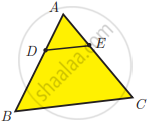Advertisements
Advertisements
प्रश्न
∠QPR = 90°, PS is its bisector. If ST ⊥ PR, prove that ST × (PQ + PR) = PQ × PR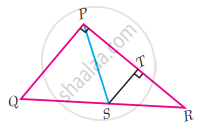
उत्तर
Given: ∠QPR = 90°; PS is the bisector of ∠P. ST ⊥ ∠PR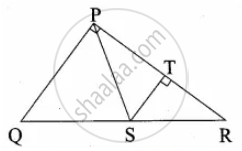
To prove: ST × (PQ + PR) = PQ × PR
Proof: In ∆PQR, PS is the bisector of ∠P.
∴ `"PQ"/"QR" = "QS"/"SR"`
Adding (1) on both side
`1 + "PQ"/"QR" = 1 + "QS"/"SR"`
`("PR" + "PQ")/"PR" = ("SR"+ "QS")/"SR"`
`("PQ" + "PR")/"PR" = "QR"/"SR"` ...(1)
In ∆RST And ∆RQP
∠SRT = ∠QRP = ∠R ...(Common)
∴ ∠QRP = ∠STR = 90°
∆RST ~ RQP ...(By AA similarity)
`"SR"/"QR" = "ST"/"PQ"`
`"QR"/"SR" = "PQ"/"ST"` ...(2)
From (1) and (2) we get
`("PQ" + "PR")/"PR" = "PQ"/"ST"`
ST × (PQ + PR) = PQ × PR
APPEARS IN
संबंधित प्रश्न
In ΔABC, D and E are points on the sides AB and AC respectively. For the following case show that DE || BC
AB = 12 cm, AD = 8 cm, AE = 12 cm and AC = 18 cm
In ΔABC, D and E are points on the sides AB and AC respectively. For the following case show that DE || BC
AB = 5.6 cm, AD = 1.4 cm, AC = 7.2 cm and AE = 1.8 cm.
If PQ || BC and PR || CD prove that `"QB"/"AQ" = "DR"/"AR"`
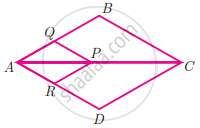
Rhombus PQRB is inscribed in ΔABC such that ∠B is one of its angle. P, Q and R lie on AB, AC and BC respectively. If AB = 12 cm and BC = 6 cm, find the sides PQ, RB of the rhombus.
Check whether AD is bisector of ∠A of ∆ABC of the following
AB = 4 cm, AC = 6 cm, BD = 1.6 cm and CD = 2.4 cm.
Construct a ∆PQR in which QR = 5 cm, ∠P = 40° and the median PG from P to QR is 4.4 cm. Find the length of the altitude from P to QR.
Construct a ∆PQR such that QR = 6.5 cm, ∠P = 60° and the altitude from P to QR is of length 4.5 cm
Construct a ∆ABC such that AB = 5.5 cm, ∠C = 25° and the altitude from C to AB is 4 cm
ST || QR, PS = 2 cm and SQ = 3 cm. Then the ratio of the area of ∆PQR to the area of ∆PST is
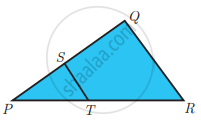
ABC is a triangle in which AB = AC. Points D and E are points on the side AB and AC respectively such that AD = AE. Show that the points B, C, E and D lie on a same circle